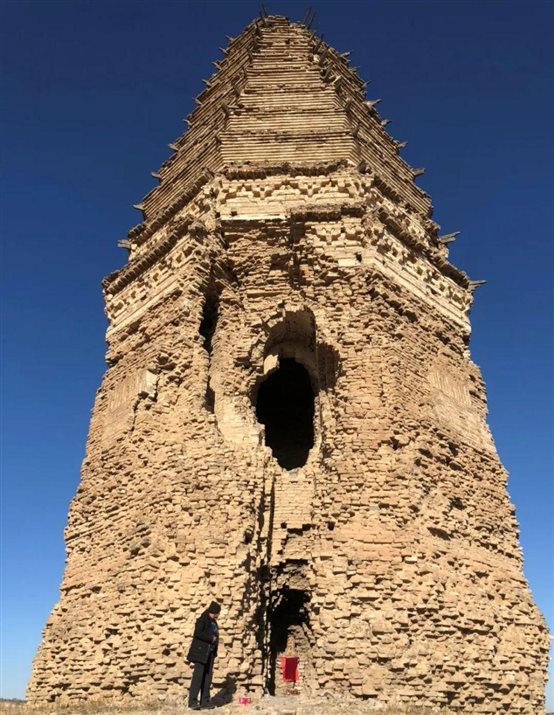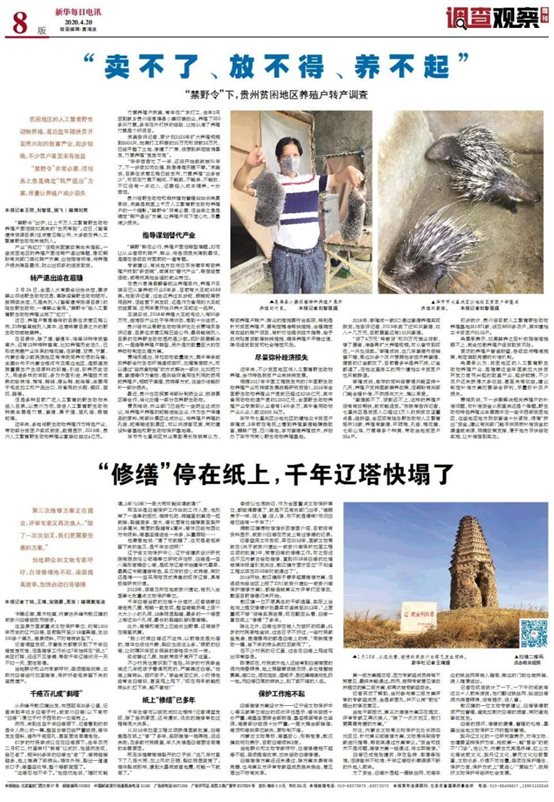The Millennium White Pagoda Is About To Collapse, Currently Tilted 3 Degrees, And Has Been "Repaired" On Paper For Many Years
Suddenly warm and still cold, the grass and trees wither and turn yellow, and the White Pagoda of Wu'an Prefecture in Aohan Banner, Chifeng City, Inner Mongolia is devastated and desolate.
This Liao Dynasty White Pagoda, which is a national key cultural relic protection unit and has a history of about 1000 years, currently has at least 18 black cracks and more than 100 black holes. The tower is tilted and bricks occasionally fall down.
The investigation by reporters found that although all parties were aware of the precariousness of the Millennium White Pagoda, the maintenance work lasted for 7 years and was constantly on paper, with no repair seen, resulting in the condition of the Millennium Liao Pagoda deteriorating day by day and facing collapse.
Local residents and industry experts are calling for an urgent need to improve efficiency, immediately reinforce and repair the White Pagoda, and protect the precious heritage left by our ancestors.
A tower with numerous holes and wounds

Starting from Aohan Banner in Chifeng City, driving west for over 30 kilometers, the reporter arrived at Baitazi Village in Fengshou Township. The White Pagoda of Wu'an Prefecture (hereinafter referred to as "the White Pagoda") is located on a high hill to the west of the village.
However, upon arriving at the foot of this millennium old white tower, what the reporter saw was a heart wrenching scene. The entire ancient pagoda has been severely damaged, with its body tilted and covered in numerous holes and even facing the risk of collapse.
67 year old villager Li Chengyi lives at the foot of the White Pagoda. On the second day of the second lunar month last year, when the village held a "sacrificial tower" ceremony, he suddenly realized that he was getting old, and the white tower that had been with him for more than 60 years was also getting old: the tower bricks were falling more and more, and the ground was piled up with broken bricks; The wall is stretched outwards, leaving long cracks; The base of the tower narrowed, causing the entire tower to tilt.
"I'm afraid this tower won't hit." He said anxiously, "It could collapse at any time. 1 year? 10 years? A heavy rain could collapse at any moment!"
Xing Yuhua is a staff member of the White Pagoda Protection Workstation. He listed a series of concerns: the wall tiles are loose, and the yellow mud in the cracks of the tiles will fall off with just one pick; The cracks have increased in number and size, with a crack on the north side of the tower even opening more than 10 centimeters, and a crack on the south side reaching 4 centimeters; The tower has tilted towards the northwest direction; The base of the tower has shrunk in for over a meter, with a heavy head and light feet
He said anxiously, "If it collapses, you'll be blind. This is a treasure left by our ancestors, a millennium old monument!"

According to research and evaluation by Liaoning Provincial Cultural Relics Protection Center, Liaoning Provincial Institute of Architectural Design and Research Co., Ltd., and other units, the White Pagoda is an octagonal dense eaved hollow pagoda. It is the earliest and most distinctive hollow brick pagoda among the existing Liao pagodas built in the mid Liao period, and the only remaining hollow brick pagoda. At the same time, it is also the only existing Liao pagoda that uses a dome style Buddhist niche, with extremely high research value.
In 2013, the tower and its location in Wuanzhou Site were listed as the seventh batch of key cultural relics protection units in China.
The current situation of the Millennium White Pagoda is very worrying. After walking around the White Pagoda for a few laps, the reporter roughly counted and found that the entire tower had hundreds of large and small holes, 18 obvious cracks, and the longest crack penetrated through the eaves of the fifth floor of the tower, with nearly 30 holes on the most common tower surface.
In addition, wild grass has grown on the eaves and top of the tower, and pigeons are building nests in the tower.
"When I was a child, the White Pagoda was not like this. Before, the walls were smooth, and the walls didn't split outward, and there weren't so many cracks." The White Pagoda in front of me surprised Li Guifen, who had been visiting her hometown for 20 years.
After a quick glance, she left here with her child.
Many villagers are also aware of the danger. 35 year old villager Li Jinhu has been watching his children to death in recent years and is strictly prohibited from approaching the White Pagoda. "I'm afraid bricks might fall off the tower and damage the children," Li Jinhu recalled. When he was a child, he often went to the White Tower to play, and even climbed up and down. "Now that you can pull the bricks off with your hands, can you not be afraid?"
Paper has been "repaired" for many years
Why did the millennium old pagoda collapse into such a state? The investigation by reporters found that in addition to natural reasons, it is also closely related to the long and inefficient maintenance approval process.
Since the reinforcement project was approved by the state in 2016, the White Pagoda has been repaired on paper for many years, but the actual repair has been delayed and has not been moved.

In the eyes of most villagers, long-term disrepair is the main reason why the White Pagoda is facing collapse.
Xing Yuhua pointed to the crack in the south wall and said, "In recent years, there have been several heavy rains in the village. With the wind and the sun, the crack has obviously widened. The wall is cracked like that. When encountering heavy rainstorm or earthquake, it may fall down."
Li Chengyi was also puzzled that as a national key cultural relic protection unit, it was so dilapidated that it was about to collapse without any action from the relevant departments. "The tower is like a house, no one manages or repairs it, isn't it collapse? Besides, the White Tower has been around for a thousand years!"
According to Tian Yanguo, the director of the Aohan Banner Museum, there is currently no information showing that the White Pagoda in Wu'an Prefecture has been repaired in history.
According to the documents reviewed by the reporter, as early as 2016, the National Cutural Heritage Administration agreed to the repair of the White Tower in the Reply on the Establishment of the Protection and Reinforcement Project of the Wu'an Prefecture Site Wu'an Tower. However, Inner Mongolia did not initiate maintenance for a long time until the situation of Baita was reported by the media in 2018, and the Aohan Banner side responded that they did not know that the project was approved in 2016.
Starting from 2018, Aohan Banner finally began to draft a maintenance plan, but submitted the "Wu'an Prefecture Site - Wu'an Prefecture Pagoda Protection and Maintenance Plan" twice to the autonomous region, which was repeatedly rejected and modified by third-party evaluations. As of now, the repair has not yet begun.
A cadre in Aohan Banner, who declined to be named, revealed that the earliest time the local government submitted a repair plan to the higher authorities could be traced back to 2013, and there was not much substantial progress in the matter. Looking back now, the White Pagoda has been "repaired" on paper for many years.
In addition, the White Pagoda also suffers from human destruction. 61 year old villager Li Guijin said that in the past, things were not easy. Some villagers built rabbit houses and pigstys using bricks from white towers. "With a strong pry of an iron rod, the bricks that fell off were taken home for use.".
In the memories of many villagers, it used to be very easy to climb in and out of the White Pagoda.
Even now, villagers or outsiders often go to the cave south of the White Pagoda to burn incense and worship Buddha, leaving paper money and ashes on the ground, and many walls are blackened. At the entrance of the tower, waste such as fireworks, wine bottles, and cans were scattered all over the ground. On the bricks around the White Pagoda, countless people's names are engraved.
Protection work cannot be delayed
The current situation assessment conducted by three units, including the Liaoning Provincial Cultural Relics Protection Center, as the designer of the maintenance plan for the White Pagoda, shows that the tower body is severely damaged; All the bricks on the base of the tower have fallen off, and there are multiple theft holes at the base; The tower body is severely damaged; All the large eaves on the first floor have fallen off; The top and brake of the tower have long been missing, and the original shape is unclear.
The Inner Mongolia Cultural Relics Bureau stated that the tower base is hollow and the situation is critical. The government of Aohan Banner stated that the White Pagoda is currently tilted 3 degrees.
Local residents and cultural relics experts are calling for the urgent need to improve efficiency and accelerate the start of the repair of the White Pagoda.
The delay in passing the maintenance plan for the White Tower is not only due to the need for improvement in the plan itself, but also due to the constant feedback and opinions from the third-party evaluation expert group members.
After the first version of the plan was submitted, it was ultimately not approved due to different opinions held by the expert group members. However, the second version of the plan, which was revised and submitted according to expert opinions, was once again rejected by the expert group.
The reporter learned from the interview that the members of the expert group who participated in the evaluation of the second version of the plan were all new faces and did not agree with the modification suggestions proposed by the "predecessor".
Local officials are concerned that the third maintenance plan is being submitted, and the evaluation experts have been replaced again. "In addition to multiple cross cuts, we need a more comprehensive maintenance plan," they said
In response, Chen Yaguang, Director of the Cultural Relics Protection Department of Inner Mongolia Cultural Relics Bureau, stated that in response to the third version of the maintenance plan, the Cultural Relics Bureau will contact experts for guidance to help it pass the plan review. "Funding and technology are not issues. Once the maintenance plan is approved, it will be repaired immediately."
The White Tower has become a dangerous building, with risks such as falling bricks and collapsing. But tourists are unaware that the Millennium Liao Pagoda attracts a constant stream of outsiders.
For safety reasons, a circle of barbed wire was erected around the perimeter of the White Pagoda. However, the barbed wire on the east side of the tower had already been trampled down by people, and the door lock on the south side had also been removed, allowing visitors to enter and exit freely.
The reporter conducted on-site statistics and found that nearly thirty people came to visit in the afternoon. They climbed over the barbed wire and entered the White Pagoda Cave to burn incense and pay homage to Buddha, without any warning or supervision.
A cultural relic expert in Aohan Banner suggests that strict management should be implemented before repairing the White Pagoda to avoid further damage to it and to prevent accidents from occurring.
The damage to the White Pagoda, slow repair, and lax management have exposed the overall predicament of local cultural relic protection work.
A researcher of Khitan Liao culture stated that when dealing with cultural relics and ancient buildings, protection should be given priority and rescue should be prioritized. Those who can receive emergency treatment should not go to outpatient clinics.
He believes that Inner Mongolia, especially Chifeng, has a dazzling array of prehistoric cultures such as Hongshan Culture, Khitan Liao Culture, and Mongolian Yuan Culture, with numerous cultural relics and immeasurable value. There is an urgent need to be "more careless" and "more awesome" in terms of protection concept, protection strength and protection method, and to coordinate cultural relics protection and economic and social development. We need to pass down many cultural relics and ancient buildings left by our ancestors.
Source: Xinhua News Agency
Note: All accompanying images in the article are reproduced online and will be deleted if infringed upon
Polpaisi steel fiber, steel fiber cut steel fiber, arranged steel fiber, cold drawn steel fiber, foreign steel fiber


